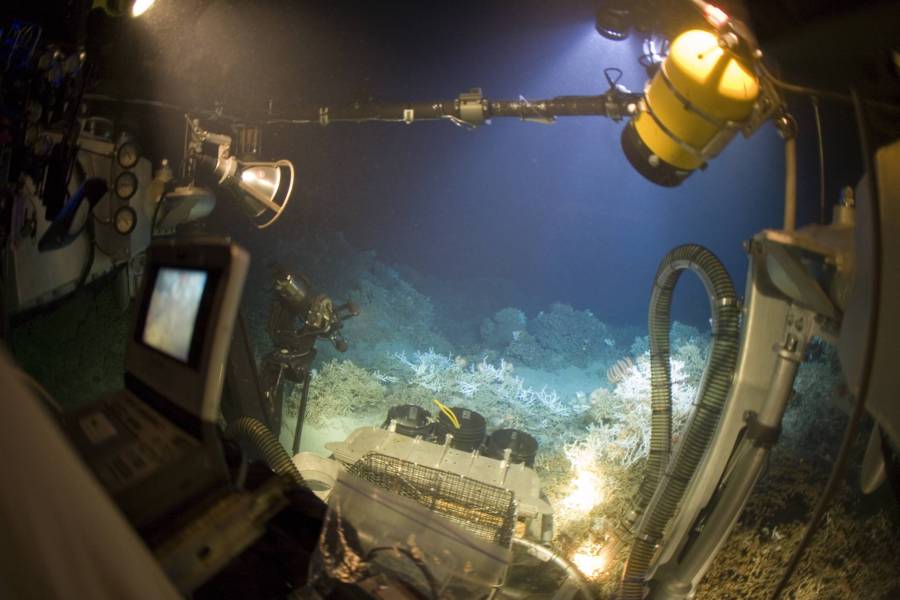The world is constantly evolving, with advancements in technology driving innovation across various industries. One such industry that is poised for a high-tech future is deep sea mining. As the demand for metals like copper, cobalt, and nickel continues to rise, the need for sustainable and ethical mining practices becomes increasingly important. Enter underwater robots, the cutting-edge solution that could revolutionize the way we extract resources from the ocean floor.
Traditional mining methods have long been associated with environmental degradation and human rights concerns. Mines where valuable metals are extracted often leave a lasting impact on the surrounding ecosystems and communities. From deforestation to water pollution, these mining operations take a toll on the planet. Additionally, the mines are sometimes located in regions where child labor and other human rights violations are prevalent, further exacerbating the ethical dilemma.
Fortunately, an alternative source of these valuable metals exists in an unlikely place—the ocean floor. With vast reserves waiting to be tapped, underwater mining has the potential to meet the growing demand for these essential materials. However, tapping into this resource comes with its own set of challenges and ethical considerations.
One company at the forefront of developing sustainable underwater mining solutions is Impossible Metals. Their groundbreaking robot prototype, Eureka, could hold the key to responsible resource extraction. Renee Grogan, the co-creator of Impossible Metals, emphasizes the importance of preserving the delicate ecosystem on the seafloor while extracting valuable resources.
Eureka, the underwater robot, is equipped with state-of-the-art technology, including artificial intelligence and an advanced retractable arm. During a test run in Lake Huron, Eureka demonstrated its ability to identify and extract metal nodules from the lakebed. The robot’s AI-driven arm delicately plucked the rocks, ensuring minimal disturbance to the surrounding environment.
Grogan explains that the AI-powered arm is capable of making decisions on whether to collect or leave a particular rock. This precision-driven approach minimizes the impact on the ecosystem, as only valuable nodules that do not contain animal products are collected. This sets underwater robots apart from traditional deep sea mining methods, which often involve dredging the ocean floor with giant robotic shovels, causing significant damage to marine life and habitats.
While Eureka’s test run in Lake Huron is a promising start, it represents just the beginning of Impossible Metals’ ambitious vision. The company aims to deploy a fleet of underwater vehicles capable of traveling up to four miles underwater. Each of these vehicles, costing approximately $5 million, will be equipped with cameras and arms to hover over the ocean floor, delicately collecting nodules without disturbing the sand or marine life.
The underwater mining process developed by Impossible Metals is akin to using tweezers rather than a bulldozer. This meticulous approach ensures that the extraction process is as environmentally friendly as possible, minimizing the negative impact on the ocean’s delicate ecosystems.
While underwater robots seem to offer a more responsible alternative to traditional mining methods, concerns regarding their feasibility and potential impact persist. The International Seabed Authority, established by the United Nations, holds the power to grant mining permits in areas such as the Clarion-Clipperton Zone. This zone, spanning approximately 2 million square miles of the Pacific Ocean, is rich in mineral deposits.
However, granting mining permits in this area could lead to extensive vacuuming of the ocean floor, potentially devastating the habitats of over 5,000 deep-sea species. Critics, including Douglas McCauley, an ocean scientist at the University of California Santa Barbara, warn against the irreversible damage that deep sea mining could inflict on marine life and the ocean’s delicate balance.
McCauley raises doubts about the feasibility of a more pinpointed approach to deep sea mining, like the one proposed by Impossible Metals. He questions whether it would be possible to extract resources with the required precision without causing unintended harm. However, Grogan remains confident in her company’s ability to navigate these challenges and move closer to a future where underwater robots are deployed on a commercial scale.
As the development of underwater robots continues to progress, the possibility of sustainable and ethical deep sea mining becomes increasingly realistic. Grogan envisions a future where underwater robots are widely deployed, revolutionizing the way we extract resources from the ocean floor. Within the next five years, she expects to see the technology reach commercial-scale implementation, potentially rendering the “Impossible” part of her company’s name obsolete.
In conclusion, underwater robots hold immense promise in ushering in a high-tech future for deep sea mining. With their precision-driven approach and advanced technology, these robots have the potential to revolutionize the industry while minimizing the negative impact on the environment. As the demand for metals continues to rise, it is crucial to prioritize sustainable and ethical mining practices. By harnessing the power of underwater robots, we can explore the vast resources of the ocean floor without causing irreparable damage to marine ecosystems. The future of deep sea mining is within reach, and underwater robots are leading the way towards a more sustainable and responsible approach to resource extraction.
First reported on CBS News
Frequently Asked Questions
What is deep sea mining, and why is it gaining attention?
Deep sea mining involves the extraction of valuable metals like copper, cobalt, and nickel from the ocean floor. It is gaining attention as traditional mining methods are associated with environmental degradation and human rights concerns. Deep sea mining offers an alternative source of these valuable metals and has the potential to meet the growing demand for essential materials.
How do underwater robots revolutionize deep sea mining?
Underwater robots, like the Eureka prototype developed by Impossible Metals, offer a more sustainable and ethical approach to resource extraction. Equipped with artificial intelligence and advanced retractable arms, these robots can delicately identify and extract metal nodules from the ocean floor, minimizing disruption to the surrounding environment and marine life.
What sets underwater robots apart from traditional deep sea mining methods?
Traditional deep sea mining methods often involve dredging the ocean floor with large robotic shovels, causing significant damage to marine life and habitats. Underwater robots, on the other hand, use a precision-driven approach, resembling “tweezers” rather than a “bulldozer.” This method ensures minimal impact on the ecosystem and reduces the negative effects of mining.
What is the potential impact of underwater robots on deep sea ecosystems?
The use of underwater robots offers a more environmentally friendly approach to deep sea mining, minimizing the negative impact on the ocean’s delicate ecosystems. The precision-driven extraction process ensures that only valuable nodules are collected, leaving behind less disruption.
What are some challenges and concerns regarding underwater mining with robots?
Concerns about the feasibility and potential impact of underwater mining with robots persist. Critics warn that even with a more pinpointed approach, unintended harm to deep-sea ecosystems could still occur. The International Seabed Authority plays a significant role in granting mining permits, and ensuring responsible mining practices is crucial.
What is the vision for the future of underwater mining with robots?
Companies like Impossible Metals envision a future where underwater robots are widely deployed on a commercial scale. They hope to revolutionize the industry by embracing sustainable and ethical mining practices, ensuring responsible resource extraction from the ocean floor.
How soon can we expect underwater robots to be used on a commercial scale for deep sea mining?
The development of underwater robots for deep sea mining is progressing rapidly. Within the next five years, companies like Impossible Metals anticipate commercial-scale implementation of their technology, moving closer to a future where underwater robots play a crucial role in sustainable resource extraction.
Why is sustainable and ethical deep sea mining important?
Sustainable and ethical deep sea mining is vital to minimize the environmental impact and protect marine ecosystems. By utilizing advanced technology like underwater robots, we can responsibly explore and extract resources from the ocean floor while addressing the growing demand for valuable metals.
What are the potential benefits of deep sea mining with underwater robots?
Deep sea mining with underwater robots offers access to vast reserves of valuable metals, helping to meet the rising global demand for these essential materials. It also presents an opportunity to transition away from traditional mining practices that have negative environmental and social consequences.
What is the significance of underwater robots in advancing technology and innovation in the mining industry?
Underwater robots represent a cutting-edge solution that can drive innovation in the mining industry. Their advanced technology, including artificial intelligence and precision-driven extraction methods, sets a new standard for sustainable and ethical mining practices. The development of underwater robots opens up possibilities for a high-tech future in deep sea mining while prioritizing environmental conservation and responsible resource extraction.
Featured Image Credit: Unsplash


















